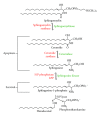Sphingolipids: a potential molecular approach to treat allergic inflammation
- PMID: 23316248
- PMCID: PMC3536436
- DOI: 10.1155/2012/154174
Sphingolipids: a potential molecular approach to treat allergic inflammation
Abstract
Allergic inflammation is an immune response to foreign antigens, which begins within minutes of exposure to the allergen followed by a late phase leading to chronic inflammation. Prolonged allergic inflammation manifests in diseases such as urticaria and rhino-conjunctivitis, as well as chronic asthma and life-threatening anaphylaxis. The prevalence of allergic diseases is profound with 25% of the worldwide population affected and a rising trend across all ages, gender, and racial groups. The identification and avoidance of allergens can manage this disease, but this is not always possible with triggers being common foods, prevalent air-borne particles and only extremely low levels of allergen exposure required for sensitization. Patients who are sensitive to multiple allergens require prophylactic and symptomatic treatments. Current treatments are often suboptimal and associated with adverse effects, such as the interruption of cognition, sleep cycles, and endocrine homeostasis, all of which affect quality of life and are a financial burden to society. Clearly, a better therapeutic approach for allergic diseases is required. Herein, we review the current knowledge of allergic inflammation and discuss the role of sphingolipids as potential targets to regulate inflammatory development in vivo and in humans. We also discuss the benefits and risks of using sphingolipid inhibitors.
Figures




Similar articles
-
Prevention of allergic disease in childhood: clinical and epidemiological aspects of primary and secondary allergy prevention.Pediatr Allergy Immunol. 2004 Jun;15 Suppl 16:4-5, 9-32. doi: 10.1111/j.1399-3038.2004.0148b.x. Pediatr Allergy Immunol. 2004. PMID: 15125698 Review.
-
IgE Sensitization to Inhalant Allergens and Its Association with Allergic Diseases in Adults.Iran J Allergy Asthma Immunol. 2018 Apr;17(2):123-133. Iran J Allergy Asthma Immunol. 2018. PMID: 29757585
-
Emerging drugs for the treatment of perennial allergic rhinitis.Expert Opin Emerg Drugs. 2016;21(1):57-67. doi: 10.1517/14728214.2016.1139082. Epub 2016 Jan 25. Expert Opin Emerg Drugs. 2016. PMID: 26733401 Review.
-
Effects of concentrated ambient particles and diesel engine exhaust on allergic airway disease in Brown Norway rats.Res Rep Health Eff Inst. 2009 Nov;(145):5-55. Res Rep Health Eff Inst. 2009. PMID: 20198910
-
Role of IgE in the development of allergic airway inflammation and airway hyperresponsiveness--a murine model.Allergy. 1999 Apr;54(4):297-305. doi: 10.1034/j.1398-9995.1999.00085.x. Allergy. 1999. PMID: 10371087 Review.
Cited by
-
Serum sphingolipids reflect the severity of chronic HBV infection and predict the mortality of HBV-acute-on-chronic liver failure.PLoS One. 2014 Aug 19;9(8):e104988. doi: 10.1371/journal.pone.0104988. eCollection 2014. PLoS One. 2014. PMID: 25136927 Free PMC article.
-
Mass Spectrometry Imaging Reveals Region-Specific Lipid Alterations in the Mouse Brain in Response to Efavirenz Treatment.ACS Pharmacol Transl Sci. 2024 Jul 9;7(8):2379-2390. doi: 10.1021/acsptsci.4c00228. eCollection 2024 Aug 9. ACS Pharmacol Transl Sci. 2024. PMID: 39156742 Free PMC article.
-
The Role of Sphingolipids in Allergic Disorders.Front Allergy. 2021 Jun 14;2:675557. doi: 10.3389/falgy.2021.675557. eCollection 2021. Front Allergy. 2021. PMID: 35386967 Free PMC article. Review.
References
-
- Jiang P, Liu J, Yan XB, Liu RY. Several interleukin-4 and interleukin-13 gene single nucleotide polymorphisms among Chinese asthmatic patients. Allergy and Asthma Proceedings. 2009;30(4):413–418. - PubMed
-
- Kay AB. Allergy and allergic diseases. First of two parts. New England Journal of Medicine. 2001;344(1):30–37. - PubMed
-
- Hakim-Rad K, Metz M, Maurer M. Mast cells: makers and breakers of allergic inflammation. Current Opinion in Allergy and Clinical Immunology. 2009;9(5):427–430. - PubMed
-
- Grimbaldeston MA, Metz M, Yu M, Tsai M, Galli SJ. Effector and potential immunoregulatory roles of mast cells in IgE-associated acquired immune responses. Current Opinion in Immunology. 2006;18(6):751–760. - PubMed
-
- Iriyoshi N, Takeuchi K, Yuta A, Ukai K, Sakakura Y. Increased expression of histamine H1 receptor mRNA in allergic rhinitis. Clinical and Experimental Allergy. 1996;26(4):379–385. - PubMed
LinkOut - more resources
Full Text Sources
